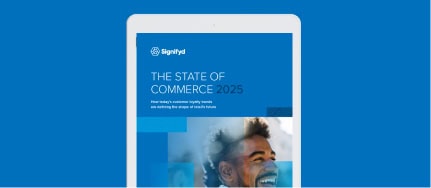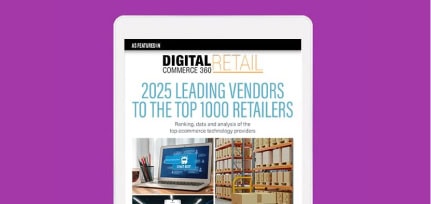With the in-person versions of major retail trade shows like Shoptalk, Adobe Summit, MRC Las Vegas cancelled or postponed due to the new coronavirus, retail industry professionals are looking for alternative ways to share knowledge, network and line up sales leads.
The shake-up has led to a surge in virtual conferences — industry gatherings online that include the sorts of educational presentations that in-person shows are known for. At Signifyd we were fortunate, for lack of a better term, to have started planning our virtual conference months before any of us had heard the term COVID-19.
The FLOW Forward Summit 2020 was an extension of a series of dinners featuring fireside chats with retail leaders that we’d been hosting across the country. The dinners were intimate, which was part of their appeal. But we wanted to find a way to scale up the value that those gatherings provided the ecommerce community.
- With all in-person conferences on indefinite hold due to COVID-19, the retail industry is hungry for opportunities to hear from thought-leaders and strategists. Networking, dealmaking and exploring partnerships are the lifeblood of any industry, and conferences provide the ideal arena for all three.
- A virtual conference can fill the void left by bans on large physical gatherings, certainly until the coronavirus pandemic subsides.
- Virtual conferences take careful planning, company alignment, a clear theme and a vendor who provides the digital venue and support for a day (or more) of learning, collaborating and commiserating with industry peers and others.
Naturally, our first thought was a full-blown, in-person conference, but it would be our first. A virtual conference, we decided, would be a prudent way to gauge the interest in a Signifyd user conference from our partners, employees and the ecommerce industry in general. It would be a way to better understand the work that goes into a conference and to test out the timing for lining up speakers and promoting the event.
We hosted the FLOW Forward Summit earlier this month, just as the coronavirus outbreak was being declared a pandemic. We lined up speakers from Rite Aid, Rad Power Bikes, Mack Weldon, Adobe, Astound Commerce and Forrester to dive into key retail issues along with our own industry thought leaders.
We met our registration goal, hosted the presentations without technical glitches and received a positive response from attendees. All-in-all a success. Most importantly, The virtual conference confirmed that we are on the right track and our community is hungry to have opportunities to engage.
1. Choosing the right vendor to host the virtual conference
Don’t cut corners when it comes to researching the right vendor to host your virtual conference. Everything that comes after this choice — the look and feel, the flexibility, the user experience and the ultimate success of the conference will flow from this early decision.
You want to ensure that the virtual venue provides a flawless user experience. Take the time to really dive into samples of past conferences that the vendor has produced. Get references and talk to them. References from the vendor, sure, but do independent research to find companies that have worked with the vendor but that aren’t on the vendor’s list of references.
The vendor should be able to provide you with samples of past user conferences and walk you through several options for your conference layout. Make sure the vendor can give you access to design your own customer experience, all the way from custom elements, colors, chat boxes and how any gamification will be integrated — including how prizes for top-scorers will be advertised. Interview wisely when selecting your vendor and don’t rush it. The time you take at this stage will save you days of time, or even weeks, later.
2. Choosing a theme for the virtual conference
Having a virtual conference is great. But don’t forget to decide why you are having a virtual conference. What is the theme, the audience? Why would busy people want to listen to what your speakers have to say? Before you can begin to market the conference and recruit speakers, you have to outline the themes and format of your conference. Think about who will be the face of your conference.
Having an individual host to provide continuity is more important at a virtual conference taking place on a screen than it is in a vast convention hall where attendees are somewhat siloed in distinct rooms.
Most importantly, before you start working in earnest, agree on what a great conference would look like in your organization’s eyes. How will you determine success — or stunning success?
Once you have your vision of success outlined, share it with your leadership team and make sure you and the C-suite are in full alignment. Once that’s established, it’s time for the fun part: Recruiting speakers, sponsors, and promoting your conference.
3. Outlining your company goals to the virtual conference
Beyond your vision of success, you also need to outline your key goals — success metrics in other words. Your measurable success can be as simple as deciding how many people you want to see register for the event. How many attendees equals success? How many speakers should you have?
Outline these numerical goals in advance, so that as you begin to count down to your conference, you can check back to make sure you are on the right track — and so you can adjust if you are not. Also, if you ever find yourself having to choose between what absolutely must get done and what might be able to slide, you can always circle back to your goals and ask yourself which task is more vital to the goals you set.
4. Aligning with cross-functional teams
To run a successful virtual conference, you need to make sure that all the relevant teams in your organization are involved and excited about the project. Don’t simply drop a fully baked idea on those who will be doing the work. Include all the teams who will be working on the conference in the early planning.
Have a kick-off meeting with all the relevant teams and ask them to point out blind spots. Is the assembled group the right one? Is anyone missing?
Listen to what experts outside your discipline have to say and act on their suggestions or clearly explain why a different path is necessary. Make sure the necessary teams are included in setting the goals and that they understand what is expected of them. Don’t forget to explain the benefits of the conference in very concrete terms to encourage sincere buy-in.
Then host ongoing scrum meetings to make sure everything remains on track and on schedule.
5. Don’t forget to celebrate and debrief
When the conference is complete don’t forget to celebrate with your teammates. A virtual conference is a major accomplishment and depending on the size of your organization, it’s possible that it required help from the vast majority of your co-workers. Take a moment. Enjoy.
And then, before too much time passes, assemble your core team for a post-mortem: What worked? What didn’t? What would you like to add? What should have started sooner in the planning phase? What was a waste of time?
The answer to those questions will become the central story of your playbook for future virtual conferences — and for the in-person conferences that success here will inevitably spawn.
Photo by Getty Images








